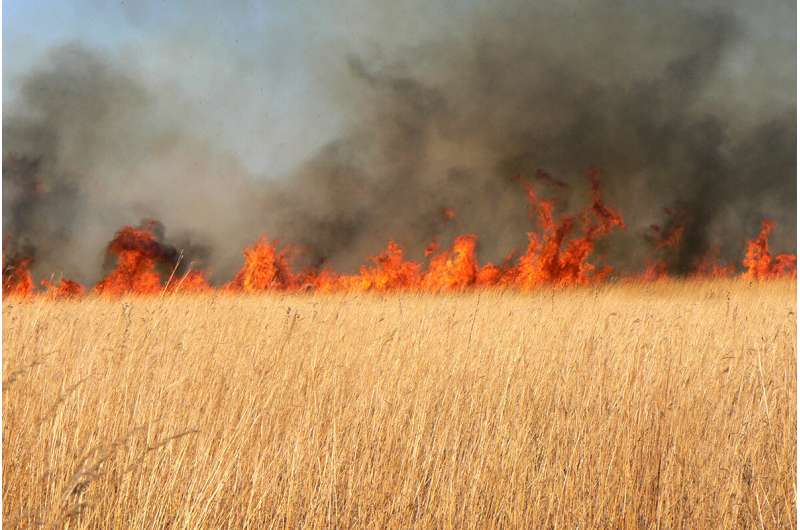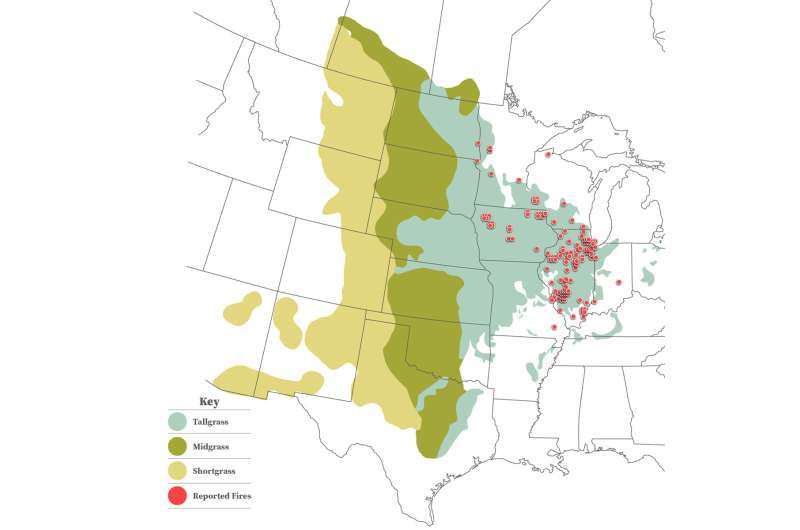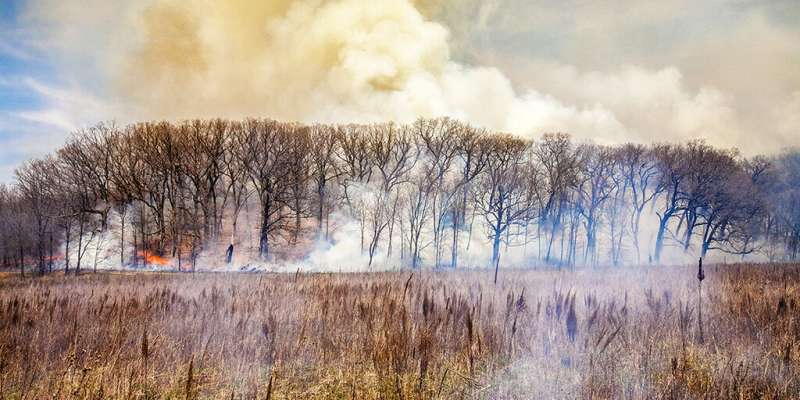Researchers conducted the most comprehensive analysis of the history of fire in the Midwestern tallgrass prairie by analyzing thousands of historical accounts dating from 1673 to 1905. Credit: Urbana Park District
Researchers combed through thousands of historical documents for first-person accounts of fires occurring between 1673 and 1905 in the Midwestern tallgrass prairie. Their study is the first systematic analysis of the timing, causes and consequences of prairie fires in this part of the world. They report their findings in Natural Areas Journal.
Although the first Europeans to travel across North America didn't know it, fire was essential to maintaining the vast grasslands they encountered in the middle of the continent. The earliest fires—usually set by Native Americans and not by lightning, the new study reveals—prevented the growth of woody plants and forest development.
The grasslands once stretched from Arizona to Ohio, and from Saskatchewan to Texas, but grew tallest on the eastern edge of their range, where rainfall was most abundant. The new study focused on this eastern swath of territory, called the Midwestern tallgrass prairie.
"Getting good data about fire from grasslands is extremely difficult, which is why we have so few studies on this subject," said study co-author Greg Spyreas, a plant ecologist at the Illinois Natural History Survey and professor of natural resources and environmental sciences at the University of Illinois Urbana-Champaign. "We can reconstruct the history of forest fires from tree-scar data, but in grasslands we have little-to-no physical evidence of what was happening in these vast Midwestern landscapes."
Study lead author William McClain, of the Illinois State Museum, scoured thousands of historical documents for accounts that included the date and location of fires, the amount of territory or property burned, any human or animal casualties, and the probable source of ignition. He and his colleagues assembled and analyzed 795 reports of fires in present-day Illinois, Indiana, Iowa, Minnesota, Missouri, North Dakota, Ohio and Wisconsin. Of those fires, 32 were reported to have been started by Native Americans and the rest by Europeans. Most of the fires attributed to Native Americans occurred in the earliest years of European expansion across the continent, before disease and displacement reduced Native populations.
"There were a lot of reasons why Native Americans used fire, and one of them was hunting for bison and deer," McClain said. "They also used it for warfare and harassment, to clear woodlands and perhaps to kill certain insects or even animals like snakes that they didn't want near their habitations."
Researchers analyzed accounts of historic tallgrass prairie fires in eight Midwestern states. Map of the central U.S., with blue-green, dark green and light green zones demarcating the original extent of the tallgrass, midgrass and shortgrass prairies, respectively. Red dots indicate the approximate location of each fire reported in the study. Credit: Michael Vincent
Early French explorers and trappers described the methods Native Americans used to encircle bison with fire when the conditions were right for containing the blaze. Sometimes their planning failed, and the fires burned out of control.
The European newcomers who settled in the tallgrass prairie feared fire, seeing it as a looming threat to life and property.
"I don't think people today realize what those prairie fires were like," said study co-author John Ebinger, a professor emeritus of biological sciences at Eastern Illinois University and an INHS affiliate. "These were not little grass fires; they were conflagrations that could quickly destroy thousands of acres."
Witnesses described fires "like a devouring army," with intentionally or unintentionally set blazes quickly growing out of control. The fires jumped over rivers; burned homes, stables, grain stores and livestock; and darkened the air with smoke that sometimes blocked out the sun for days. One observer in Minnesota in 1857 described prairie fires "that licked the country clean" for hundreds of miles. Another reported in 1873 that a "smoky atmosphere in autumn (in the Midwest) has been the common experience every year, and this smokiness has its origin in prairie fires."
Most fires occurred in October and November, the driest time of year on the prairie and a period the settlers called "Indian summer."
Fires started by Native Americans decreased over time as their populations dwindled, the researchers found, but European newcomers began setting fires to clear the land for crops or to kill pests, and the frequency of fires increased between 1830 and 1850. After that, railroad expansion and farming practices fragmented the prairies, diminishing the likelihood that grass fires would spread over great distances.
The new study fills in some major gaps in scientists' understanding of the history of fire in North American grasslands, the researchers said.
Prairie fire at the Nature Conservancy’s Nachusa Grasslands near Franklin Grove, Illinois. Credit: Charles Larry
"This study is incredibly useful, because a lot of what we do today in managing these lands is based on assumptions, not data," Spyreas said. "With this study, we have really well-organized data that says some very clear things. For example, it says that most of the fires were happening in the fall and that in many cases they were huge."
The study also challenges a widespread assumption about the origin of the prairie fires, McClain said. Of the hundreds of first-person accounts analyzed, only five prairie fires were ignited by lightning. This runs counter to a longstanding argument that the prairies were maintained by fires sparked by lightning, he said.
Embers from coal-fired locomotives occasionally lit the prairie on fire, the team reported. Many more blazes were intentionally set—as campfires or to remove crop residue—but quickly spread out of control. The frequency of destructive fires eventually led to new laws meant to prevent such occurrences.
"Europeans adopted some of the fire practices of Native Americans," said study co-author Charles Ruffner, a forestry professor at Southern Illinois University. "And then when those fire practices became less amenable to the landscape, we started having legislation to stop them."
While the new study offers the first reliable history of fire in the tallgrass prairie between the late 17th century and early 1900s, the research has its limitations, Ruffner said. For example, not all fires were documented in the public record.
"Fire became such a common occurrence that people weren't writing about the everyday fires," he said. "They only wrote about the ones that burned up whole townships and killed people."
More information: William E. McClain et al, Patterns of Anthropogenic Fire within the Midwestern Tallgrass Prairie 1673–1905: Evidence from Written Accounts, Natural Areas Journal (2021). DOI: 10.3375/20-5
Journal information: Natural Areas Journal
Provided by University of Illinois at Urbana-Champaign


























